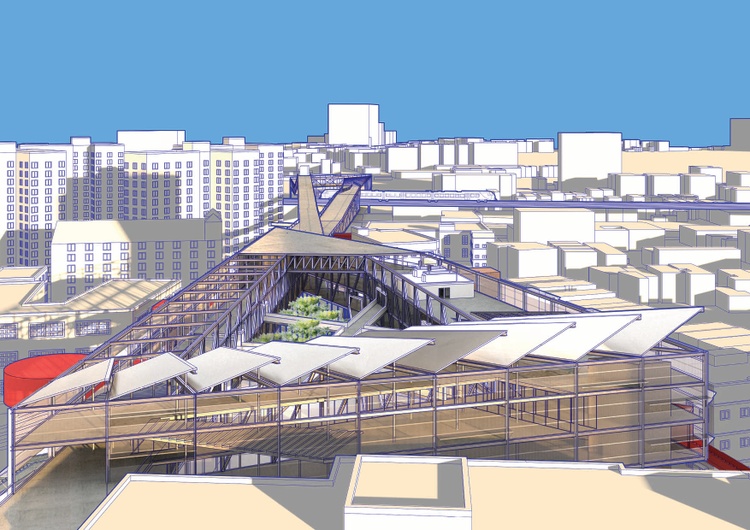Understanding the Collaborative Process Between Architects and Designers in Modern Building And Construction Projects
The collective procedure in between architects and engineers is essential in contemporary construction jobs, as it integrates style intent with engineering usefulness. Discovering these characteristics reveals insights that can considerably influence project results and general market criteria.
The Significance of Cooperation
The joint synergy between engineers and engineers is vital for the effective realization of any type of building and construction project. This partnership brings with each other unique expertise and point of views, allowing the combination of cutting-edge design with useful engineering options. By interacting, designers and designers can make certain that a task not only meets aesthetic and practical demands however additionally abides by safety and security, sustainability, and budgetary restraints.
Cooperation cultivates a common vision, facilitating the alignment of goals and expectations from the outset. This alignment is important in attending to prospective difficulties and mitigating dangers that can emerge throughout the task lifecycle. A collective technique enables for the effective allotment of resources, maximizing both time and price.
The value of partnership prolongs to the iterative procedure of style and building and construction, where feedback from designers can educate architectural decisions, bring about even more possible and sustainable layouts. On the other hand, designers can inspire designers to think artistically regarding how to achieve architectural integrity without compromising creative intent. Eventually, the joint connection between engineers and designers is not merely valuable; it is essential to the creation of high-grade, practical, and innovative constructed environments that meet the needs of culture.
Communication Techniques and Devices
Effective interaction techniques and tools are essential for promoting cooperation between engineers and engineers throughout the task lifecycle. Establishing clear networks of communication is vital to make sure that all staff member are aligned with job purposes, timelines, and obligations. Normal meetings, both in-person and online, offer possibilities for stakeholders to talk about progression, address concerns, and make notified choices.
Making use of project administration software, such as BIM (Building Info Modeling) systems, improves cooperation by enabling real-time sharing of style alterations and technical specifications. These tools promote openness, allowing designers and engineers to picture adjustments and examine their influence on the overall project.

Shared Objectives and Project Vision

Establishing shared objectives involves open discussion and an extensive understanding of each technique's contributions. Engineers generally concentrate on design intent, spatial connections, and customer experience, while engineers highlight structural honesty, systems performance, and conformity with regulations (cda architects). When these point of views are straightened, the outcome is a cohesive job that complies with both creative goals and technological usefulness
Furthermore, a distinct project vision promotes liability amongst team members, motivating each individual to take possession of their role in achieving the desired result. Routine check-ins and joint workshops can better strengthen this dedication, enabling changes to be made as the project progresses. Eventually, a common vision not just boosts synergy yet additionally boosts the top quality of the last deliverable, leading to successful job conclusion.
The Function of Innovation
Leveraging technology has actually ended up being essential in improving collaboration in between architects and designers. The integration of advanced software program devices helps with real-time interaction and information sharing, enabling groups to work extra effectively and article source properly. Building Details Modeling (BIM) stands apart as a crucial technology, enabling both engineers and engineers to produce detailed 3D designs that envelop design intent and structural stability. This common graph decreases misunderstandings and enhances the decision-making process.
Moreover, cloud-based platforms allow seamless partnership, permitting task stakeholders to access and update project data from anywhere. This fosters a society of transparency and accountability, as changes can be tracked and evaluated in real-time. Furthermore, mobile applications additional improve communication, supplying on-site teams with instant access to project specifications and updates.
Emerging technologies such as artificial knowledge and device discovering are likewise beginning to play a function in predictive analysis, helping groups recognize prospective problems before they occur. Ultimately, the role of modern technology in architecture-engineering partnership not only improves operations performances however likewise enhances innovation, bring about even more successful project end results. By welcoming these technical developments, architects and designers can make sure an extra natural and efficient collaborative procedure throughout the building lifecycle.
Study in Effective Collaborations
Many study show the extensive influence of efficient collaborations in between architects and designers on project outcomes. One remarkable example is the collaboration on the High Line in New York City City, where landscape architects, designers, and urban organizers collaborated to change an abandoned railway into a vivid public park. This multidisciplinary method not just enhanced the visual high quality yet likewise ensured structural safety and security and environmental sustainability.
An additional exemplary instance is the style and building and construction of the Sydney Music Hall. The collaboration between designer JÃ ¸ registered nurse Utzon and structural designer Ove Arup exhibited innovative analytical. Their cooperation permitted the famous shell-like design while attending to complex design obstacles, ultimately causing a classic architectural masterpiece.
The Burj Khalifa in Dubai better shows the importance of collective initiatives. cda architects. The assimilation of architecture and engineering expertise allowed the job team to achieve unprecedented heights while adhering like this to security laws and visual vision
These examples underscore the significance of communication, depend on, and shared purposes. In today's intricate building and construction environment, such partnerships are necessary to browsing obstacles and supplying tasks that meet both Get More Info functional and visionary goals.
Conclusion
In conclusion, the collaboration between architects and engineers is vital for the success of modern-day building and construction tasks. Reliable communication techniques, a shared project vision, and the integration of innovative modern technologies are critical parts that promote this collaboration. By promoting a culture of accountability and leveraging devices such as Structure Info Modeling (BIM), teams can navigate task complexities, guaranteeing that aesthetic, useful, and sustainability purposes are accomplished. Ultimately, this synergy brings about ingenious and successful project end results.